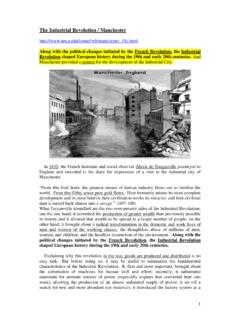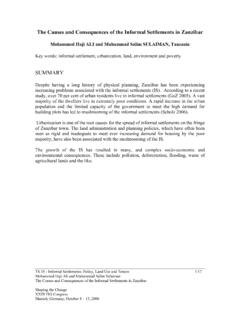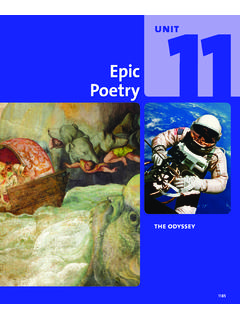Transcription of Ferdinand Magellan’s Voyage and its Legacy in the Philippines
1 Proceedings of The National Conference On Undergraduate Research (NCUR) 2020 Montana State University, Bozeman MT March 26-28, 2020 Ferdinand magellan s Voyage and its Legacy in the Philippines Emma Jackson History Liberty University 1971 University Blvd. Lynchburg, Virginia 24515 USA Faculty Advisor: David Snead Abstract During the fifteenth century, the expanding Spanish empire changed the course of history for the lands that it conquered. The economic and territorial rivalry between the two Iberian powers, Spain and Portugal, led to Ferdinand magellan s famed attempt to circumnavigate the globe in 1519. magellan , the Portuguese explorer sailing for Spain, intended to find a western route to the lucrative Spice Islands, but instead he found himself in the Philippine Islands.
2 magellan and his crew developed relationships with the Filipino natives and won the first converts to Christianity in the country. In an effort to demonstrate Spanish military power to their new Filipino allies, the Spanish entered into a battle with the Chief Lapu-Lapu, in which magellan lost his life. This paper seeks to explore the significant cultural and societal impact that magellan s expedition left in the Philippines . magellan s exploration of the Philippines paved the way for the Spanish colonization of the Philippines , introduced Catholicism and the revered Sto. Nino icon to the islands, and made a national hero of Lapu-Lapu, who still lives on in the memory of the people.
3 This paper analyzes the primary source accounts of magellan s Voyage , government documents, newspaper articles, and secondary analyses of Filipino oral traditions in an attempt to understand the cultural impact of the first contact with Europeans in the Philippines . While a cursory fact in the west, magellan s exploration of the Philippines and his death at the battle of Mactan changed the course of Philippine history and remain embedded in the national consciousness. Keywords: Ferdinand magellan , Philippines , Age of Exploration 1. Introduction In the early sixteenth century, the growing Spanish empire desired access to trade in the Spice Islands, which proved a problem due to the Line of Demarcation decided in the Treaty of Tordesillas by Pope Alexander This line of demarcation roughly split the globe in half between the two Iberian powers, Spain and Portugal.
4 To gain access to the Spice Islands, it was necessary for Spain to find a western route to avoid sailing through Portuguese territory. A Portuguese sailor working for Spain, Ferdinand magellan , believed that a western route, going around South America, existed that would lead to the Spice Islands. On their expedition, magellan s crew discovered the Philippine Islands, among other territories. Unlike other peoples they encountered, the natives of what is now called the Philippines lived in a highly developed society that was connected to the eastern world through trade. magellan entered into alliances with the natives and became entwined in tribal warfare.
5 His expedition brought Christianity to the Philippines , which remains the dominant religion to this day. magellan lost his life at the hands of Filipino natives while engaged in a battle against the now legendary figure, Chief Lapu-Lapu. Decades after magellan s death, the Spanish would return to the Philippines to finish the process of colonizing the islands. magellan s quest to find a western route to the Spice Islands helped shape the history and culture of the Philippine Islands and remains embedded in the national consciousness. 927 2. Body In 1518, magellan received support from King Charles of Spain, who agreed to sponsor his The king agreed to finance the journey, promising percentages of the potential revenues to magellan and his partners, as he expected the expedition to bring in large profits from the lucrative spice magellan s five ships set sail from the port of Seville on September 20, The Voyage proved to be eventful and lacked nothing in setbacks and hardships.
6 While anchored for the winter in St. Julian Bay in Patagonia, magellan s crew mutinied, led by Juan de Cartegna, Gaspar Quesada, and Antonio de The expedition ran into further hardship when they lost the ship Santiago on an exploring After successfully finding the straight, named in magellan s honor, and passing into the Pacific Ocean, the crew sailed for three months without finding any food, leaving many men malnourished and The Voyage chronicler, Pigafetta, notes, daily we made runs fifty, sixty, or seventy leagues with the wind at the windward side or at the stern, and had not God and His blessed mother given us such good weather we would all have died of hunger in that exceedingly vast sea.
7 8 After further misadventures with the natives on what they dubbed Island of Thieves, magellan s expedition landed on an island in what is now the Philippines on Sunday March 16, This European discovery of the Philippines impacted the courses of both Philippine and Spanish history. When the Spanish made landfall in the Philippines , they encountered a developed society, one not at all isolated from the outside world. As early as the ninth century, the Philippines were engaging in trade with the Chinese by way of Arab The Filipinos possessed a written language, likely inherited from Sanskrit or The Filipinos already had some knowledge of Europeans when the Spanish first made contact as the people of Cebu were aware of the Portuguese due to their trade connections.
8 A merchant from Siam warned Rajah Humabon, the ruler of Cebu, that he should respect the white men, who he confused as Portuguese, because they conquered Calicut, Malacca, and all India Major. 12 Jose Amiel Angeles argues that the Philippines treated the Spaniards as they would any other potential enemy or ally because they perceive them as being their The Filipinos, coming from a developed society, did not show any of the shock that the inhabitants of the Americas faced upon encountering Europeans. 14 The Spaniards first came into contact with native Filipinos from Homonhon Island on March 18, Shortly after they met and built a positive relationship with Rajah Colambu of Butuan According to Pigafetta, magellan showed the Rajah s men the many spices that the Spanish carried with them in order to honor The men indicated that some of those spices grew in the place where the Spanish were going, which could have meant the Moluccas (the Spice Islands)
9 Or the Philippine Islands magellan had motivation to find islands rich in resources such as spices because he was promised a heavy percentage of the revenues from two of the Islands he discovered, after King Charles picked six islands for As the Moluccas were already claimed by Portugal, magellan s hope for territorial gain lay in islands such as the Philippines that were previously unknown to Europeans. magellan s desire to take two Islands for himself could explain why magellan s expedition stayed in the Philippines for so long, when their goal was to find the A lasting impact of magellan s time in the Philippines is the spread of Catholicism in the islands.
10 On Easter Sunday, March 31, 1521, magellan s crew celebrated the first mass in the The Kings Rajah Colambu and Rajah Siagu were present at the mass and showed reverence to the Richard Field argues that the first mass was most likely heard onboard the ship on March 16 but was not recorded by Pigafetta, as he only recorded departures from regular displays of religion such as eating meat on Good The expedition arrived at the Island of Cebu on Sunday April 7 and sent an ambassador and an interpreter, magellan s slave Enrique, to meet Rajah Humabon, the king of John Leddy Phelan notes that, It was not until his arrival in Cebu that the religious sentiments of magellan s nature began to assert themselves with vehemence and ardor.




